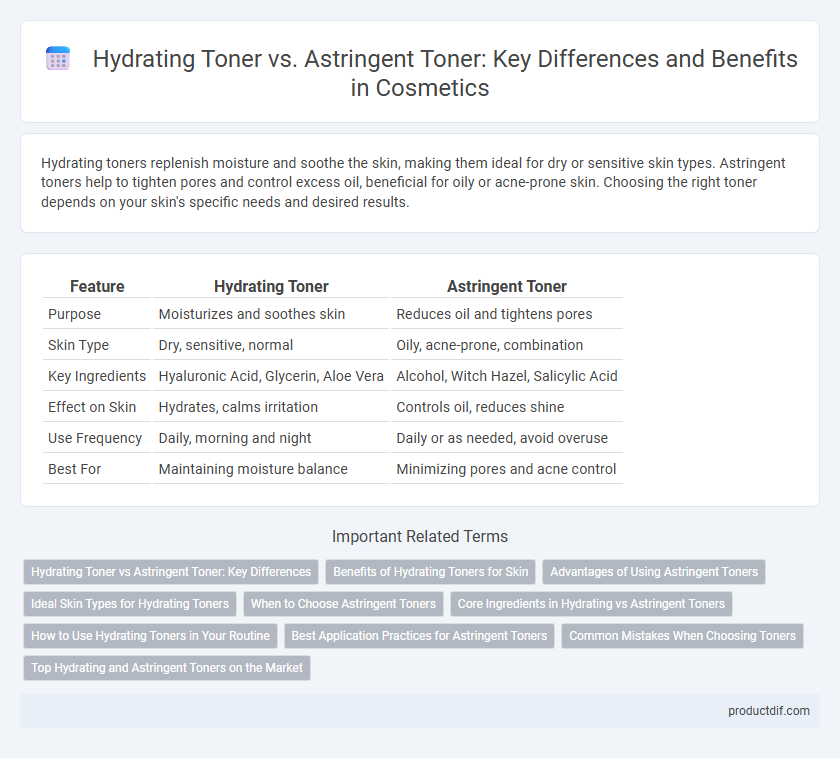Hydrating toners replenish moisture and soothe the skin, making them ideal for dry or sensitive skin types. Astringent toners help to tighten pores and control excess oil, beneficial for oily or acne-prone skin. Choosing the right toner depends on your skin's specific needs and desired results.
Table of Comparison
| Feature | Hydrating Toner | Astringent Toner |
|---|---|---|
| Purpose | Moisturizes and soothes skin | Reduces oil and tightens pores |
| Skin Type | Dry, sensitive, normal | Oily, acne-prone, combination |
| Key Ingredients | Hyaluronic Acid, Glycerin, Aloe Vera | Alcohol, Witch Hazel, Salicylic Acid |
| Effect on Skin | Hydrates, calms irritation | Controls oil, reduces shine |
| Use Frequency | Daily, morning and night | Daily or as needed, avoid overuse |
| Best For | Maintaining moisture balance | Minimizing pores and acne control |
Hydrating Toner vs Astringent Toner: Key Differences
Hydrating toner primarily replenishes moisture and soothes the skin, ideal for dry or sensitive skin types, while astringent toner targets excess oil and tightens pores, making it suitable for oily or acne-prone skin. The key difference lies in their ingredients: hydrating toners contain humectants like glycerin and hyaluronic acid, whereas astringent toners often include alcohol or witch hazel to reduce oiliness. Selecting between hydrating and astringent toner depends on individual skin needs, balancing moisture retention against oil control.
Benefits of Hydrating Toners for Skin
Hydrating toners deliver essential moisture to the skin, enhancing hydration levels and supporting the skin's natural barrier function to prevent dryness and irritation. They are rich in ingredients like hyaluronic acid, glycerin, and botanical extracts, which soothe sensitive skin while improving elasticity and radiance. Unlike astringent toners that often contain alcohol and can strip natural oils, hydrating toners promote a balanced complexion, making them ideal for dry or sensitive skin types.
Advantages of Using Astringent Toners
Astringent toners effectively minimize pores and control excess oil production, making them ideal for oily and acne-prone skin types. Their antiseptic properties help reduce inflammation and prevent breakouts by removing residual impurities and tightening the skin. Unlike hydrating toners, astringent toners provide a mattifying effect, resulting in a smoother complexion with less shine.
Ideal Skin Types for Hydrating Toners
Hydrating toners are ideal for dry, sensitive, and mature skin types due to their focus on replenishing moisture and soothing irritation without stripping the skin's natural oils. Formulated with ingredients like hyaluronic acid, glycerin, and aloe vera, these toners help maintain optimal hydration levels and improve skin elasticity. Unlike astringent toners, which contain alcohol or witch hazel to reduce oil and tighten pores, hydrating toners support barrier repair and enhance overall skin softness.
When to Choose Astringent Toners
Astringent toners are ideal for oily and acne-prone skin types as they help to reduce excess sebum and tighten enlarged pores. Use astringent toners after cleansing to control shine and prevent breakouts by minimizing the appearance of pores and removing residual oil. Avoid astringent toners if you have sensitive or dry skin, as their higher alcohol content may cause irritation and dryness.
Core Ingredients in Hydrating vs Astringent Toners
Hydrating toners primarily feature ingredients like hyaluronic acid, glycerin, and aloe vera, which attract and retain moisture to maintain skin's hydration balance. Astringent toners contain core components such as witch hazel, alcohol, and salicylic acid that help reduce oiliness, tighten pores, and control excess sebum production. Understanding the distinct functionalities of these ingredients enables optimal selection for dry or oily skin types.
How to Use Hydrating Toners in Your Routine
Hydrating toners should be applied immediately after cleansing to lock in moisture and prep the skin for serums and moisturizers. Use a cotton pad or your hands to gently pat the toner onto the face, allowing the skin to fully absorb the nourishing ingredients like hyaluronic acid or glycerin. Incorporate hydrating toners twice daily, morning and night, to maintain optimal skin hydration and improve the skin's texture and elasticity.
Best Application Practices for Astringent Toners
Astringent toners work best when applied after cleansing, using a cotton pad to gently sweep the face, targeting oily or acne-prone areas to minimize pores and control excess sebum. Avoid applying astringent toners on dry or sensitive skin to prevent irritation or excessive dryness. For optimal results, follow with a hydrating moisturizer to maintain skin balance and prevent dehydration.
Common Mistakes When Choosing Toners
Many skincare enthusiasts confuse hydrating toners with astringent toners, mistakenly selecting products that strip the skin of essential moisture rather than replenishing it. Using an astringent toner on dry or sensitive skin can cause irritation, redness, and increased oil production as a rebound effect. Properly identifying your skin type and understanding toner ingredients like hyaluronic acid for hydration or witch hazel for astringent effects is crucial for effective skincare.
Top Hydrating and Astringent Toners on the Market
Top hydrating toners like Klairs Supple Preparation Facial Toner and Hada Labo Gokujyun Premium Hydrating Lotion deliver intense moisture with ingredients such as hyaluronic acid and glycerin, promoting plump and refreshed skin. Leading astringent toners including Thayers Witch Hazel Toner and Paula's Choice Skin Balancing Pore-Reducing Toner feature witch hazel and salicylic acid to control oil, tighten pores, and reduce acne. Choosing between hydrating and astringent toners depends on individual skin needs, with hydrating options benefiting dry or sensitive skin and astringents ideal for oily or acne-prone types.
Hydrating Toner vs Astringent Toner Infographic

 productdif.com
productdif.com